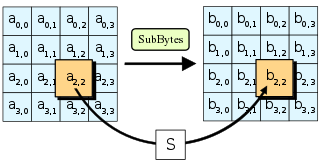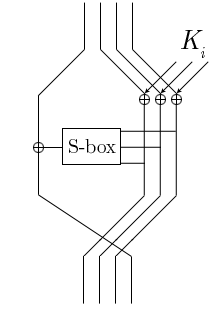Related Research Articles

The Advanced Encryption Standard (AES), also known by its original name Rijndael, is a specification for the encryption of electronic data established by the U.S. National Institute of Standards and Technology (NIST) in 2001.

The Data Encryption Standard is a symmetric-key algorithm for the encryption of digital data. Although its short key length of 56 bits—criticized from the beginning—makes it too insecure for most current applications, it has been highly influential in the advancement of modern cryptography.
Differential cryptanalysis is a general form of cryptanalysis applicable primarily to block ciphers, but also to stream ciphers and cryptographic hash functions. In the broadest sense, it is the study of how differences in information input can affect the resultant difference at the output. In the case of a block cipher, it refers to a set of techniques for tracing differences through the network of transformation, discovering where the cipher exhibits non-random behavior, and exploiting such properties to recover the secret key.
In cryptography, RC4 is a stream cipher. While it is remarkable for its simplicity and speed in software, multiple vulnerabilities have been discovered in RC4, rendering it insecure. It is especially vulnerable when the beginning of the output keystream is not discarded, or when nonrandom or related keys are used. Particularly problematic uses of RC4 have led to very insecure protocols such as WEP.

A stream cipher is a symmetric key cipher where plaintext digits are combined with a pseudorandom cipher digit stream (keystream). In a stream cipher, each plaintext digit is encrypted one at a time with the corresponding digit of the keystream, to give a digit of the ciphertext stream. Since encryption of each digit is dependent on the current state of the cipher, it is also known as state cipher. In practice, a digit is typically a bit and the combining operation is an exclusive-or (XOR).
A5/1 is a stream cipher used to provide over-the-air communication privacy in the GSM cellular telephone standard. It is one of seven algorithms which were specified for GSM use. It was initially kept secret, but became public knowledge through leaks and reverse engineering. A number of serious weaknesses in the cipher have been identified.
In cryptography, Camellia is a symmetric key block cipher with a block size of 128 bits and key sizes of 128, 192 and 256 bits. It was jointly developed by Mitsubishi Electric and NTT of Japan. The cipher has been approved for use by the ISO/IEC, the European Union's NESSIE project and the Japanese CRYPTREC project. The cipher has security levels and processing abilities comparable to the Advanced Encryption Standard.
In cryptography, MISTY1 is a block cipher designed in 1995 by Mitsuru Matsui and others for Mitsubishi Electric.
In cryptography, KHAZAD is a block cipher designed by Paulo S. L. M. Barreto together with Vincent Rijmen, one of the designers of the Advanced Encryption Standard (Rijndael). KHAZAD is named after Khazad-dûm, the fictional dwarven realm in the writings of J. R. R. Tolkien. KHAZAD was presented at the first NESSIE workshop in 2000, and, after some small changes, was selected as a finalist in the project.
In cryptography, Khufu and Khafre are two block ciphers designed by Ralph Merkle in 1989 while working at Xerox's Palo Alto Research Center. Along with Snefru, a cryptographic hash function, the ciphers were named after the Egyptian Pharaohs Khufu, Khafre and Sneferu.

In cryptography, MacGuffin is a block cipher created in 1994 by Bruce Schneier and Matt Blaze at a Fast Software Encryption workshop. It was intended as a catalyst for analysis of a new cipher structure, known as Generalized Unbalanced Feistel Networks (GUFNs). The cryptanalysis proceeded very quickly, so quickly that the cipher was broken at the same workshop by Vincent Rijmen and Bart Preneel.
Turing is a stream cipher developed by Gregory G. Rose and Philip Hawkes at Qualcomm for CDMA.
Anubis is a block cipher designed by Vincent Rijmen and Paulo S. L. M. Barreto as an entrant in the NESSIE project, a former research program initiated by the European Commission in 2000 for the identification of new cryptographic algorithms. Although the cipher has not been included in the final NESSIE portfolio, its design is considered very strong, and no attacks have been found by 2004 after the project had been concluded. The cipher is not patented and has been released by the designers for free public use.
HC-256 is a stream cipher designed to provide bulk encryption in software at high speeds while permitting strong confidence in its security. A 128-bit variant was submitted as an eSTREAM cipher candidate and has been selected as one of the four final contestants in the software profile.
In cryptography, SC2000 is a block cipher invented by a research group at Fujitsu Labs. It was submitted to the NESSIE project, but was not selected. It was among the cryptographic techniques recommended for Japanese government use by CRYPTREC in 2003, however, has been dropped to "candidate" by CRYPTREC revision in 2013.
In cryptography, Hierocrypt-L1 and Hierocrypt-3 are block ciphers created by Toshiba in 2000. They were submitted to the NESSIE project, but were not selected. Both algorithms were among the cryptographic techniques recommended for Japanese government use by CRYPTREC in 2003, however, both have been dropped to "candidate" by CRYPTREC revision in 2013.
In cryptography, M6 is a block cipher proposed by Hitachi in 1997 for use in the IEEE 1394 FireWire standard. The design allows some freedom in choosing a few of the cipher's operations, so M6 is considered a family of ciphers.
In cryptography, a T-function is a bijective mapping that updates every bit of the state in a way that can be described as , or in simple words an update function in which each bit of the state is updated by a linear combination of the same bit and a function of a subset of its less significant bits. If every single less significant bit is included in the update of every bit in the state, such a T-function is called triangular. Thanks to their bijectivity regardless of the used Boolean functions and regardless of the selection of inputs, T-functions are now widely used in cryptography to construct block ciphers, stream ciphers, PRNGs and hash functions. T-functions were first proposed in 2002 by A. Klimov and A. Shamir in their paper "A New Class of Invertible Mappings". Ciphers such as TSC-1, TSC-3, TSC-4, ABC, Mir-1 and VEST are built with different types of T-functions.
In cryptography, a distinguishing attack is any form of cryptanalysis on data encrypted by a cipher that allows an attacker to distinguish the encrypted data from random data. Modern symmetric-key ciphers are specifically designed to be immune to such an attack. In other words, modern encryption schemes are pseudorandom permutations and are designed to have ciphertext indistinguishability. If an algorithm is found that can distinguish the output from random faster than a brute force search, then that is considered a break of the cipher.
The following outline is provided as an overview of and topical guide to cryptography:
References
- Dai Watanabe, Soichi Furuya, Kazuo Takaragi, Bart Preneel (February 2002). A New Keystream Generator MUGI (PDF). 9th International Workshop on Fast Software Encryption (FSE 2002). Leuven: Springer-Verlag. pp. 179–194. Retrieved 2007-08-07.CS1 maint: multiple names: authors list (link)
- Jovan Dj. Golic (February 2004). A weakness of the Linear Part of Stream Cipher MUGI. 11th International Workshop on Fast Software Encryption (FSE 2004). Delhi: Springer-Verlag. pp. 178–192.
- Alex Biryukov; Adi Shamir (February 2005). Analysis of the Non-linear Part of Mugi. 12th International Workshop on Fast Software Encryption (FSE 2005). Paris: Springer-Verlag. pp. 320–329. Archived from the original (PostScript) on 2006-05-15. Retrieved 2007-08-07.